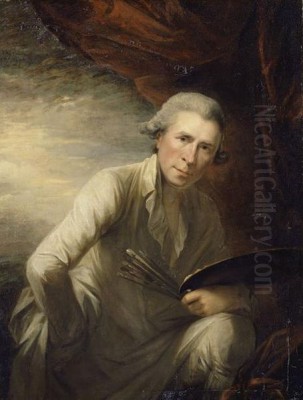
George Romney stands as one of the titans of British portraiture during the latter half of the 18th century. Flourishing in the vibrant artistic landscape of Georgian London, he captured the likenesses of the era's elite with a distinctive grace and fluidity that set him apart. While often mentioned in the same breath as his esteemed contemporaries Sir Joshua Reynolds and Thomas Gainsborough, Romney carved his own unique niche, becoming arguably the most fashionable portrait painter of his day, particularly sought after for his sensitive and elegant depictions of women and children. His life and career offer a fascinating glimpse into the world of art, patronage, and society during a period of significant cultural transformation in Britain.
Early Life and Artistic Awakening
George Romney was born in 1734 in Dalton-in-Furness, a town then in Lancashire but now part of Cumbria, in the North West of England. His father was a respected local cabinet maker, a trade that perhaps instilled in the young Romney an appreciation for craftsmanship and form. From an early age, George displayed a natural inclination towards drawing and visual arts, a talent that did not go unnoticed.
His formal artistic training began relatively late compared to some of his peers. At the age of fifteen, he started his initial artistic endeavors. However, his first significant step into professional training occurred in 1755, when he was apprenticed to Christopher Steele, an itinerant portrait painter based in Kendal. Steele, though not a major figure himself, provided Romney with foundational skills in the techniques of portrait painting. Romney's early works from this period show Steele's influence, particularly in their bright colour palettes and the adept handling of fabrics and drapery.
Despite this apprenticeship, much of Romney's artistic development appears to have been driven by his own diligent study and practice. He was, in many respects, largely self-taught, absorbing lessons from observation and experimentation. He spent about two years with Steele before setting out independently, initially working as a portrait painter in the northern counties of England.
The Move to London and Rise to Prominence
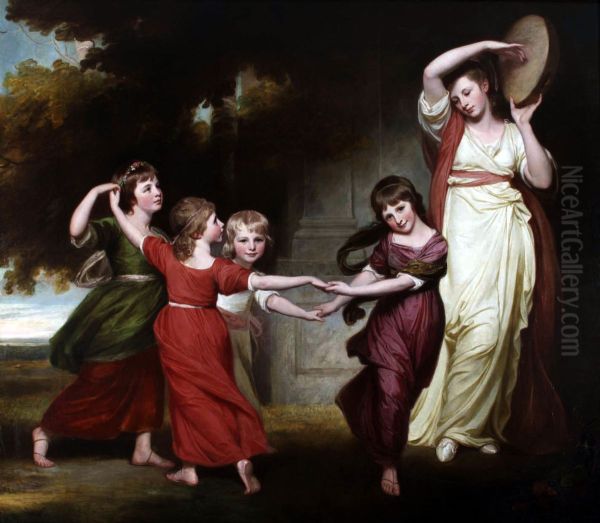
The provincial art scene, however, could not contain Romney's ambition or fully nurture his burgeoning talent. In 1762, seeking greater opportunities and recognition, he made the pivotal decision to move to London, the bustling epicentre of British art and society. This move proved transformative for his career.
His arrival in the capital coincided with a growing demand for portraiture among the wealthy and influential. Romney quickly sought to make his mark. A significant breakthrough came when he submitted a historical painting, The Death of General Wolfe, to a competition held by the Royal Society of Arts (then known simply as the Society of Arts). Although the circumstances surrounding the award were somewhat complex, involving debates about historical accuracy and artistic merit compared to a rival work by Edward Penny, Romney was ultimately awarded a second prize. This recognition brought his name to public attention and served as a crucial stepping stone.
From this point forward, Romney's reputation grew rapidly. He established a studio and began attracting a clientele drawn from the ranks of the aristocracy, gentry, politicians, and cultural figures. His ability to produce flattering yet insightful likenesses, combined with a relatively swift painting process compared to some rivals, made him an increasingly popular choice. Within a few years, he had become one of the most sought-after and fashionable portrait painters in London.
Artistic Style: Elegance, Classicism, and Rococo Grace
George Romney's mature artistic style is characterized by its elegance, fluidity, and a distinct blend of Rococo grace with Neoclassical sensibilities. He possessed a remarkable ability to capture the refined gestures and subtle emotions of his sitters, imbuing his portraits with a sense of life and movement. His lines are often described as flowing and lyrical, contributing to the overall harmony and decorative quality of his compositions.

A profound understanding and appreciation of classical sculpture deeply informed his work. This is evident in the often statuesque poses of his figures, the simplified backgrounds that focus attention on the sitter, and the smooth, idealized rendering of features. His trip to Italy between 1773 and 1775 was crucial in this regard. There, he immersed himself in the study of classical antiquities and the works of Renaissance and Baroque masters. He spent time in Rome, Venice, Bologna, Florence, and Parma, absorbing the lessons of artists like Raphael and Titian. His time in Parma exposed him to the sensuous grace of Correggio, whose influence can be detected in the soft modelling and gentle expressions found in some of Romney's subsequent work.
Before his Italian sojourn, a trip to Paris in 1764 had also broadened his horizons. There, he encountered the work of French artists, meeting the landscape painter Joseph Vernet and likely absorbing influences from the prevailing Rococo style, perhaps through figures like Nicolas Le Sueur or the highly successful Carle van Loo. This French influence likely contributed to the lightness, elegance, and decorative sensibility that remained a hallmark of his style, even as Neoclassical ideals gained prominence.
Romney particularly excelled in the portrayal of women and children. He captured feminine beauty with a sensitivity and charm that few could match, often depicting his female sitters in graceful, slightly informal poses, dressed in flowing, simple gowns that emphasized the lines of the figure rather than elaborate court dress. His portraits of children are noted for their tenderness and lack of stiff formality, capturing a sense of youthful innocence and spontaneity. His colour palette, while capable of richness, often favoured softer, harmonious tones that enhanced the overall elegance of the image.
The Portraitist in Demand
Throughout the 1770s and 1780s, Romney's studio was one of the busiest in London. He commanded substantial fees and worked prolifically, producing a vast number of portraits that documented the upper echelons of Georgian society. His sitters included leading politicians, military figures, aristocrats, intellectuals, and their families. His popularity rivalled, and at times perhaps even surpassed, that of Sir Joshua Reynolds, the President of the Royal Academy.
Among his many celebrated portraits are works like The Gower Children (c. 1776-77), a masterful group portrait depicting the children of the 2nd Earl Gower with dynamic composition and individualised characterisation. His portrait of Sir John Forbes showcases his ability to convey male authority and intellect. Lady Elizabeth Stanley, Countess of Derby (c. 1776-78), now in the Metropolitan Museum of Art, New York, is a quintessential example of his elegant female portraiture, capturing the sitter's aristocratic poise.
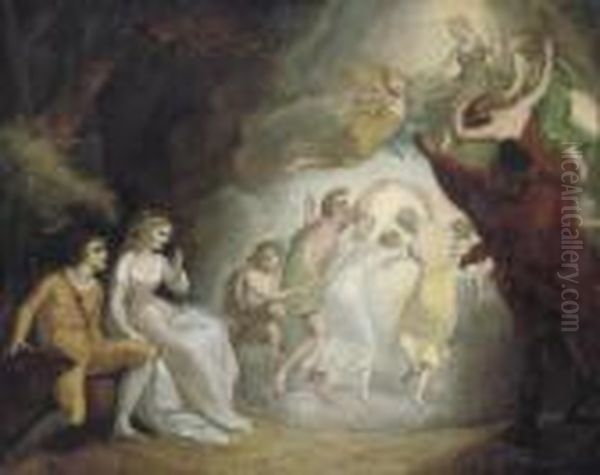
Other notable works demonstrate the breadth of his portrait practice: Lady Lemon (Jane Buller, mid-1780s) is famed for its graceful composition and delicate handling. Mrs. Cooke (1787-89), housed in the Tate Britain, exemplifies his skill in rendering textures and capturing a thoughtful expression. The double portrait Jane Maxwell, Duchess of Gordon and Her Son, George Duncan, located in the Scottish National Gallery, displays his adeptness at complex compositions involving multiple figures. Works like Portrait of Two Girls (Misses Cumberland) (MFA Boston), Mrs. Anne Broadstone (National Portrait Gallery, London), and Miss Juliana Willoughby (National Gallery of Art, Washington D.C.) further attest to his consistent quality and appeal.
The Divine Emma: A Muse for the Ages
No account of George Romney's life and art is complete without discussing his relationship with Emma Hart, later famous as Lady Hamilton, the mistress of Admiral Lord Nelson. Romney first met Emma around 1781 or 1782, when she was the young mistress of Charles Greville. Greville, possibly seeking portraits of his beautiful companion, introduced her to Romney. The painter was instantly captivated by her beauty, expressiveness, and natural ability to pose.
What followed was one of the most famous artist-muse relationships in British art history. Over the next decade, particularly intensely in the early 1780s before she moved to Naples with Sir William Hamilton (Greville's uncle, whom she later married), Romney painted Emma obsessively. It is estimated he created over 60 portraits of her in various guises and formats. She became far more than just a model; she was an inspiration, a collaborator who enacted roles drawn from mythology, literature, and history, as well as posing for straightforward, albeit highly idealized, portraits.
These paintings, often referred to collectively as his 'Emma' series, showcase Romney's art at its most imaginative and expressive. He depicted her as Circe, a Bacchante, Medea (as seen in Lady Hamilton as Medea), Joan of Arc, Mary Magdalene, and in numerous allegorical roles representing states of mind or abstract concepts ('Sensibility', 'Mirth'). These works allowed Romney to explore themes and compositions beyond the constraints of conventional commissioned portraiture. Emma's famous 'Attitudes' – performances where she used shawls and simple props to evoke classical sculptures and emotional states – were likely developed in part through her sessions with Romney. The Emma portraits were immensely popular and further cemented Romney's fame, though some contemporaries perhaps viewed the sheer volume and intensity of this artistic relationship with curiosity or even disapproval.
Ambitions Beyond Portraiture: The Lure of History Painting
Despite his overwhelming success as a portraitist, Romney harboured ambitions in the field of 'high art', particularly history painting, which was considered the most prestigious genre according to academic theory, championed by figures like Sir Joshua Reynolds. Romney felt the constraints of "face-painting," as portraiture was sometimes dismissively called, and yearned to create grand narrative works based on historical, mythological, or literary subjects.
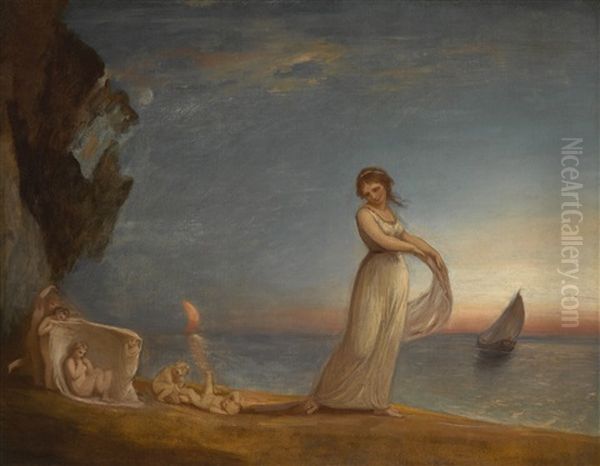
His Italian journey was partly motivated by this desire, allowing him to study the great history painters of the past. Throughout his career, he produced numerous sketches and studies for historical compositions, often drawing inspiration from classical texts and, notably, from the plays of William Shakespeare. He was a great admirer of the Bard and contributed works to John Boydell's ambitious Shakespeare Gallery project, which aimed to foster a British school of history painting.
However, Romney's efforts in history painting never achieved the same level of critical or popular acclaim as his portraits. Works like his interpretations of The Tempest or A Midsummer Night's Dream were often ambitious in scale and conception but sometimes struggled with complex multi-figure compositions or failed to fully capture the dramatic intensity of their subjects. His painting for A Midsummer Night's Dream, for instance, was reportedly criticized for being overly elaborate and was not ultimately included in the main Boydell Gallery exhibition, causing the sensitive artist considerable disappointment.
Some critics, both then and later, suggested that Romney's true genius lay in the intimacy and elegance of portraiture, and that his talents were less suited to the demands of grand historical narratives. His dedication to these ambitious but less successful projects sometimes drew criticism, with suggestions that he was neglecting the genre where his mastery was undisputed. This internal conflict between his lucrative portrait practice and his aspirations towards 'higher' art forms remained a recurring theme in his career.
Personality, Rivalry, and the Royal Academy
George Romney's personality played a significant role in shaping his career and his relationships within the London art world. He was known to be intensely sensitive, somewhat shy, prone to bouts of melancholy, and plagued by self-doubt, despite his enormous success. This introspective and sometimes anxious temperament contrasted sharply with the more socially adept and institutionally savvy Sir Joshua Reynolds.
This difference in personality likely contributed to the well-documented rivalry between Romney and Reynolds. While both artists dominated the portrait market, they represented different facets of the art establishment. Reynolds, as President of the Royal Academy, was the embodiment of official artistic authority. Romney, on the other hand, consciously kept his distance from the Academy. He never exhibited there after his early submissions to the Society of Arts and Incorporated Society of Artists, and crucially, he never sought membership in the Royal Academy, despite his stature.
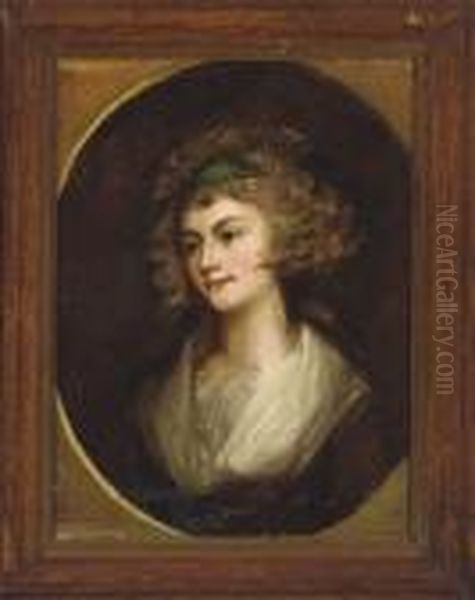
Romney's reasons for shunning the RA were complex. He seems to have harboured a distrust of academic institutions and artistic politics, perhaps feeling that true talent did not require official validation. He may also have felt slighted by the Academy or by Reynolds personally in his early career. This decision, however, meant he operated outside the main institutional framework of British art, relying solely on his talent and connections to sustain his practice. It also meant he lacked the platform the Academy exhibitions provided for showcasing ambitious works, potentially hindering his history painting aspirations. His studio on Cavendish Square became his primary showcase, attracting numerous visitors, including prominent figures like the writer and politician Edmund Burke.
His main rival in terms of style and popularity, besides Reynolds, was Thomas Gainsborough, whose fluid brushwork and sensitivity, particularly in female portraits, offered a different kind of appeal. Other prominent portraitists of the era included John Hoppner, who became a direct competitor in the later part of Romney's career, and figures like Angelica Kauffman, a founding member of the RA known for both portraits and history paintings, and Benjamin West, an American-born painter who succeeded Reynolds as RA President and specialized in historical subjects. Romney navigated this competitive environment largely on his own terms, sustained by a loyal clientele who admired his unique blend of elegance and insight. His style can be seen as part of a lineage of elegant British portraiture influenced by earlier masters like Sir Anthony van Dyck.
Later Years, Legacy, and Reappraisal
George Romney maintained a demanding workload for decades. His surviving account books and sketchbooks attest to his prolific output; estimates suggest he produced around 2,000 paintings and perhaps as many as 5,000 drawings over his career. However, the relentless pace eventually took a toll on his health, which was often fragile. By the late 1790s, his physical and mental condition began to decline.
Financial pressures may also have played a part in his later years. Maintaining a large London studio and household was expensive, and despite his high earnings, he seems to have suffered periods of financial anxiety. These factors, combined with declining health, led him to effectively retire from his London practice. In 1799, in poor health, he returned to Kendal in the north, where his estranged wife, Mary, had lived throughout his London career (a separation maintained apparently by mutual, if distant, consent). She cared for him in his final years until his death in 1802. He was buried in Dalton-in-Furness, his birthplace.
Romney's historical reputation has fluctuated. Immensely famous in his lifetime, his standing somewhat declined during the Victorian era. Critics then sometimes found his work charming but lacking the perceived psychological depth of Reynolds or the painterly bravura of Gainsborough. His elegance was occasionally misinterpreted as superficiality.

However, the 20th century saw a significant reappraisal of his art. Scholars and curators began to look afresh at his technical skill, his sophisticated understanding of line and form, his contribution to the development of Neoclassicism in Britain, and the genuine sensitivity evident in his best portraits, particularly those of Emma Hamilton and children. His drawings, often bold and experimental, also gained greater appreciation, revealing a more searching and sometimes darker aspect to his artistic personality than his finished oils might suggest.
Today, George Romney is firmly recognized as one of the leading figures of 18th-century British art. While Reynolds might represent the academic establishment and Gainsborough the lyrical connection to landscape and nascent Romanticism, Romney embodies a particular strain of Neoclassical elegance fused with Rococo charm. His ability to capture the grace and sensibility of his age, particularly its leading women, remains remarkable. His portraits offer not just likenesses, but enduring images of Georgian society's ideals of beauty, refinement, and poise. Artists like Sir Thomas Lawrence, who rose to prominence at the end of Romney's career, certainly inherited the tradition of elegant portraiture that Romney had helped to define.
Conclusion
George Romney's journey from a cabinet maker's son in rural Lancashire to one of London's most celebrated portrait painters is a testament to his innate talent and relentless dedication. His art, characterized by fluid lines, classical poise, and an almost unparalleled ability to convey elegance and grace, captured the spirit of his age. Though he wrestled with ambitions in history painting and maintained a complex relationship with the official art institutions, his supremacy in portraiture was undeniable. Through iconic works and his legendary series of portraits of Emma Hamilton, Romney created images that continue to fascinate and enchant viewers today. He remains a pivotal figure in the rich tapestry of British art history, an artist whose elegant eye defined the look of Georgian England for generations to come.